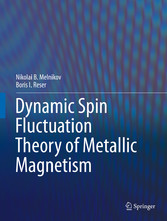Suche
Lesesoftware
Info / Kontakt
Dynamic Spin-Fluctuation Theory of Metallic Magnetism
von: Nikolai B. Melnikov, Boris I. Reser
Springer-Verlag, 2018
ISBN: 9783319929743 , 284 Seiten
Format: PDF, Online Lesen
Kopierschutz: Wasserzeichen




Preis: 96,29 EUR
eBook anfordern 
Preface
6
Contents
7
List of Symbols
11
1 Introduction
17
References
20
2 Basics of Metallic Magnetism
22
2.1 Magnetic Susceptibility: Macroscopic Approach
22
2.1.1 Generalized Magnetic Susceptibility
22
2.1.2 Symmetry Relations
24
2.1.3 Dispersion Relations
25
2.2 Magnetic Susceptibility: Microscopic Approach
26
2.2.1 Magnetization and Spin
26
2.2.2 Linear Response Theory
28
2.2.3 Fluctuation-Dissipation Theorem
31
References
34
3 Many-Electron Problem
35
3.1 One-Electron States
35
3.2 Many-Electron States
37
3.3 Second Quantization
38
3.3.1 General Theory
38
3.3.2 Specific Operators
39
Charge Density
39
Spin Density: Wannier Representation
40
Spin Density: Bloch Representation
41
Single-Site Spin
42
Hamiltonian
42
3.4 Noninteracting Electrons
43
References
47
4 Mean-Field Theory
48
4.1 The Hubbard Model
48
4.2 Stoner Mean-Field Theory
50
4.2.1 Hartree-Fock Approximation
50
4.2.2 Magnetization: The T2 Law
52
4.2.3 Uniform Static Susceptibility
54
4.3 Band Calculations in Metals
55
References
56
5 Random-Phase Approximation
57
5.1 Magnetic Susceptibilities
57
5.1.1 Longitudinal Susceptibility
57
5.1.2 Transverse Susceptibility
60
5.2 Magnetic Excitations
62
5.2.1 Spin-Density Waves
62
5.2.2 Magnetization: The T3/2 Law
65
5.2.3 Stoner Spin-Flip Excitations
67
References
68
6 Green Functions at Finite Temperatures
70
6.1 Fermion-Type Green Functions
70
6.1.1 Real-Time Green Function
70
General Properties
70
Equation of Motion
71
Spectral Function
72
6.1.2 Temperature Green Function
74
Relation with Charge and Spin Density
74
Relation with the Real-Time Green Function
75
6.2 Boson-Type Green Functions
76
6.2.1 Dynamic Susceptibility
77
Longitudinal Susceptibility
77
Transverse Susceptibility
79
6.2.2 Thermodynamic Susceptibility
81
Relation with the Spin Correlator
81
Relation with the Dynamic Susceptibility
82
Noninteracting Electrons
83
Summation Rule
84
Measurement and Calculation Methods
85
References
86
7 Spin Fluctuation Theory in the Ising Model
87
7.1 Spins in the Fluctuating Field
87
7.2 Approximations of the Free Energy
89
7.2.1 Quadratic Part of the Free Energy
89
7.2.2 Higher-Order Terms of the Free Energy
90
7.3 Local Fluctuating Field
91
7.4 Magnetic Phase Diagrams
92
References
94
8 Functional Integral Method
95
8.1 Multiband Hubbard Hamiltonian
95
8.1.1 Intraatomic Interaction and Hund's Rule
95
8.1.2 Atomic Charge and Spin Density
97
8.2 Functional Integral over Fluctuating Fields
99
8.2.1 Thermodynamic ``Time'' Dependence
99
8.2.2 Electrons in the Fluctuating Field
100
8.2.3 Charge Fluctuations
102
8.3 Exact Relations
104
8.3.1 Field-Dependent Thermodynamic Potential
104
8.3.2 Mean Spin and Spin-Density Correlator
107
References
108
9 Gaussian Approximation
110
9.1 Motivation
110
9.2 Saddle-Point Approximation
111
9.3 Free Energy Minimum Principle
113
9.4 Optimal Gaussian Approximation
114
9.4.1 General Formulation
114
9.4.2 Ferromagnetic State
114
9.4.3 Self-Energy Equation
115
References
117
10 Single-Site Gaussian Approximation
118
10.1 Coherent Potential Equation
118
10.2 Single-Site Gaussian Fluctuating Field
120
10.3 Mean Single-Site Green Function
122
10.4 Basic Magnetic Characteristics
123
10.5 Application to Ferromagnetic Metals
125
10.5.1 Iron
125
10.5.2 Cobalt
127
10.5.3 Nickel
129
10.5.4 Comparison with Other Studies
129
References
130
11 High-Temperature Theory
131
11.1 Problem of Temperature Dependence
131
11.1.1 Discontinuous Jump of Magnetization
131
11.1.2 Instability Through Multiple Solutions
132
11.1.3 Temperature Hysteresis
133
11.2 Beyond the Gaussian Approximation
137
11.2.1 Renormalized Gaussian Approximation
137
11.2.2 Local and Uniform Fluctuations
139
11.2.3 Application to Fe and Fe–Ni Invar
140
Iron
140
Fe-Ni Invar
140
References
142
12 Low-Temperature Theory
144
12.1 Low-Temperature Region
144
12.1.1 Transverse Dynamic Susceptibility
144
12.1.2 Spin Waves and T3/2 Law
147
12.2 Beyond the Spin Waves
150
12.2.1 Low-Temperature DSFT
150
12.2.2 Application to Fe and Fe-Ni Invar
151
References
153
13 Temperature Dependence of Magnetic Characteristics
155
13.1 Temporal Correlation Function
155
13.2 Qualitative Analysis of Spin Correlations
157
13.3 Spin Correlations in the One-Electron Approximation
158
13.3.1 Unenhanced Susceptibilities
158
13.3.2 Computational Formulae
160
13.3.3 Band and Model Calculations
162
13.3.4 Interim Conclusions
164
13.4 Magnetic Properties in the DSFT
165
13.4.1 Local Magnetic Characteristics
165
13.4.2 Nuclear Spin Relaxation Rates
170
References
174
14 Neutron Scattering in Metals
176
14.1 Scattering Cross-Section
176
14.2 Scattering Potential Correlator
178
14.3 Neutron Scattering and Phonons
180
14.3.1 Lattice Vibrations
180
14.3.2 Debye-Waller Factor
182
References
184
15 Short-Range Order Above TC
185
15.1 Magnetic Neutron Scattering
185
15.1.1 Magnetic Interaction Potential
185
15.1.2 Nonpolarized Magnetic Scattering
186
15.1.3 Polarized Magnetic Scattering
187
15.2 Spin-Density Correlations
189
15.2.1 Spatial Spin Correlator
190
15.2.2 Spin Correlator in the DSFT
191
15.2.3 High-Temperature Approximation
192
15.3 Application to Iron
192
15.3.1 Comparison of DSFT and Experiment
192
15.3.2 Short-Range Order Analysis
195
References
197
16 Conclusion
199
Appendices
201
A Basic Mathematical Results
202
B Concepts Related to Functional Integral
227
C Fourier Transformations
237
D Dynamic Susceptibility in the RPA
248
E Proofs of Four Results in the DSFT
252
F Basic Approximations in Scattering Theory
259
G Lattice Vibrations in the Harmonic Approximation
264
H Numerical Integral Transformations
270
I DSFT Solution Methods and Software
277
Index
282





